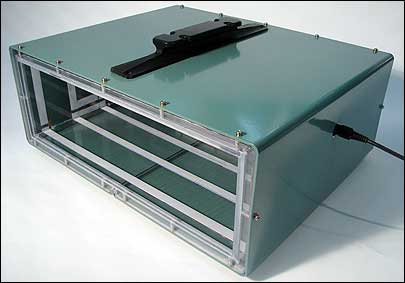Magellan Technology, an Australian manufacturer of 13.56 MHz RFID systems, has unveiled a system designed to catalogue and track thousands of medical specimen slides.
The system was created specifically for laboratories, hospitals and other organizations that need to store and track thousands of tiny glass slides containing lab samples and other biological material. Labs and other health-care institutions must accurately label and track specimens throughout processing and storage to avoid—in a worst-case scenario—mix-ups between patients.

Being able to track the specimens, particularly during the development and production of new pharmaceuticals, can help companies comply with regulations issued by the U.S. Food and Drug Administration (FDA) and other agencies, says Ken Laing, Magellan Technology’s VP of sales and marketing. “As you can imagine, there can be up to 10,000 slides produced during the development process of a drug,” he says, “and each of these slides must be stored and easily accessible in the case of a recall or FDA query.”
But tracking the slides isn’t easy. According to Laing, specimen slides typically measure either 20 by 15 millimeters or 20 by 10 millimeters, and are generally tracked using bar codes, or typed or hand-written labels. Slides are generally stored very close to or touching each other, in specially designed boxes.
Magellan’s system leverages the company’s Phase Jitter Modulation (PJM) StackTag technology. In 2007, the firm incorporated the technology in a document-tracking application designed to identify, read and encode passive tags, even if the documents to which they are attached are buried at the bottom of a deep stack of other tagged documents (see Magellan Technology Releases RFID Products for Document Tracking). PJM StackTag employs Magellan’s PJM technology, which complies with the ISO 18000 Part 3 Mode 2 standard, to enable tags to be encoded at a data rate of up to 424 kilobits per second, and read at a rate of 106 kilobits per second.
The system for tracking specimen slides uses a newly designed boxlike antenna, Laing says, and can read the tags on up to 1,000 slides in about two seconds, even if they are stacked one on top of the other. Not only can the interrogator read the tags, but it can also be used to write to the tags, though that process takes slightly longer than two seconds.
The PJM StackTag labels can be affixed to one end of the slides, and a Magellan MARS interrogator can be mounted under or in a convenient position near a lab table. The tunnel antenna is plugged into the reader with a cable, but sits on top of the table. “The antenna was designed in a tunnel shape to allow for the box of tags to slide in, and to allow for the tags to be identified irrespective of which end of the slide the tag was placed,” says Laing. When a box of slides is set on the table, the interrogator reads the tags’ unique ID numbers.
Magellan offers several reader options that can be employed to track slides. According to Laing, the company suggests the MARS-24 if a customer wants to identify 1,000 slides in less than two seconds. “If speed is not an issue and you only want to identify the tags in, say, eight seconds, then a MARS 1-6 can do the job,” Laing says. “The difference is that a MARS-24 has eight reply channels, and the MARS 1-6 has only two reply channels.”
Magellan created the new system, which is available now, at the request of a company that had been using RFID tags based on the ISO 15693 standard to track specimen slides. “However, for [that system] to work, only 16 slides could be stored [together] in a box, and the slides needed to be stored in a particular way to ensure the tags did not touch,” Laing states. “The RFID technology that supports ISO 15693 was developed many years ago for asset and access-control applications. It was not developed for item-level tagging, unlike Magellan’s PJM technology.”
A global drug company is currently testing the Magellan slide-tracking technology. The firm, which Laing says he is not at liberty to name, has a number of scientists developing new pharmaceuticals or working to enhance existing drugs. During drug development, Laing says, “samples of the prospective drugs are placed on slides together with, say, a sample from a frozen tumor, and the results are tested. These samples need to be referenced all the time—hence the need for an efficient method of identifying the location of the sample.”
The drugmaker is testing the PJM technology to help it determine which box contains a particular slide. Then, to pinpoint the exact slide, the company breaks the box down further into 10 other boxes, each containing 100 slides. Each box is placed in the tunnel antenna until the specific slide is located. “This takes a couple of minutes, instead of hours,” Laing says.

